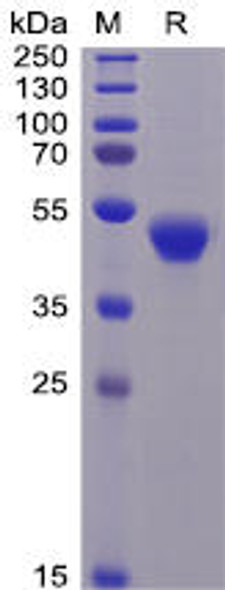Description
| Product Name: | Human CD5 / Cluster of Differentiation 5 Recombinant Protein (His tag) |
| Product Code: | RPES5557 |
| Size: | 20µg |
| Species: | Human |
| Expression Host: | E.coli |
| Synonyms: | T-cell surface glycoprotein CD5, CD5, Lymphocyte antigen T1/Leu-1 |
| Mol Mass: | 38.17 kDa |
| AP Mol Mass: | 41 kDa |
| Tag: | N-His |
| Purity: | > 95 % as determined by reducing SDS-PAGE. |
| Endotoxin Level: | Please contact us for more information. |
| Bio Activity: | Testing in progress |
| Sequence: | Arg 25-Pro 372 |
| Accession: | P06127 |
| Storage: | Generally, lyophilized proteins are stable for up to 12 months when stored at -20 to -80°C. Reconstituted protein solution can be stored at 4-8°C for 2-7 days. Aliquots of reconstituted samples are stable at < -20°C for 3 months. |
| Shipping: | This product is provided as lyophilized powder which is shipped with ice packs. |
| Formulation: | Lyophilized from sterile PBS, pH 7.4. Normally 5 % - 8 % trehalose, mannitol and 0.01% Tween80 are added as protectants before lyophilization. Please refer to the specific buffer information in the printed manual. |
| Reconstitution: | Please refer to the printed manual for detailed information. |
| Background: | The cluster of differentiation (CD) system is commonly used as cell markers in immunophynotyping. Different kinds of cells in the immune system can be identified through the surface CD molecules which associating with the immune function of the cell. There are more than 320 CD unique clusters and subclusters have been identified. Some of the CD molecules serve as receptors or ligands important to the cell through initiating a signal cascade which then alter the behavior of the cell. Some CD proteins do not take part in cell signal process but have other functions such as cell adhesion. CD5 is a member of the CD system. CD5 was found to be widely distributed in T-cells and B1 cells which is a subset of IgM-secreting B cells. CD5 also was found expressed in small lymphocytic lymphoma, hairy cell leukaemia and mantle cell lymphoma cells. CD5 serves to weaken the activating stimulus from the BCR so that the B1 cells can only reflect to the very strong stimuli but not the normal tissue proteins. |






